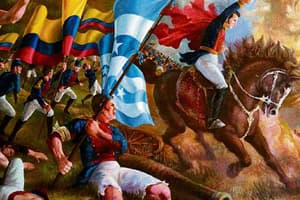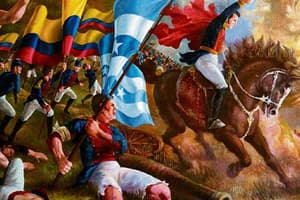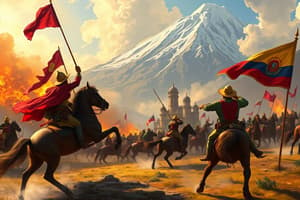Podcast
Questions and Answers
What was the initial strategy employed by General Antonio José de Sucre in the lead-up to the Battle of Pichincha?
What was the initial strategy employed by General Antonio José de Sucre in the lead-up to the Battle of Pichincha?
- An indirect approach through the Andes (correct)
- A direct assault on Quito from the north
- A diversionary tactic involving local peasants
- A naval blockade of royalist ships
Which group did NOT contribute soldiers to the patriotic army during the Battle of Pichincha?
Which group did NOT contribute soldiers to the patriotic army during the Battle of Pichincha?
- British battalion
- Spanish royalists (correct)
- Irish soldiers
- Veterans from New Granada
How many royalist soldiers did the patriotic forces encounter in Cuenca?
How many royalist soldiers did the patriotic forces encounter in Cuenca?
- 1,600
- 3,300
- 900 (correct)
- 2,000
What was a significant action taken by Sucre following the capture of Cuenca?
What was a significant action taken by Sucre following the capture of Cuenca?
What was the combined strength of the patriotic forces after joining with the Peruvian soldiers?
What was the combined strength of the patriotic forces after joining with the Peruvian soldiers?
What was the main goal of the intelligence gathering activities?
What was the main goal of the intelligence gathering activities?
What significant strategy did Sucre employ during his advance?
What significant strategy did Sucre employ during his advance?
What action did Sucre take when his forces reached the town of Sangolquí?
What action did Sucre take when his forces reached the town of Sangolquí?
What caused the patriots’ ascent of Pichincha Volcano to be slower than expected?
What caused the patriots’ ascent of Pichincha Volcano to be slower than expected?
How did Sucre decide to handle the situation when the British forces were delayed?
How did Sucre decide to handle the situation when the British forces were delayed?
What critical action did Aymerich take upon realizing Sucre's strategy?
What critical action did Aymerich take upon realizing Sucre's strategy?
What was the final outcome of the battle around midday on May 24?
What was the final outcome of the battle around midday on May 24?
What offer did Sucre make to Aymerich after the victory at Pichincha?
What offer did Sucre make to Aymerich after the victory at Pichincha?
How did the arrival of British reinforcements impact the battle?
How did the arrival of British reinforcements impact the battle?
What happened to Lieutenant Abdón Calderón during the course of the battle?
What happened to Lieutenant Abdón Calderón during the course of the battle?
Flashcards
Battle of Pichincha location
Battle of Pichincha location
The Battle of Pichincha took place on the slopes of Pichincha Volcano near Quito, Ecuador.
Sucre's strategy
Sucre's strategy
General Sucre used an indirect approach, traveling through Cuenca before reaching Quito and utilizing Andes terrain.
Patriot army composition
Patriot army composition
The patriot army included veterans, local recruits, soldiers from different nations (Venezuela, New Granada, etc.) , and former Spanish troops.
Combined force size
Combined force size
Signup and view all the flashcards
Sucre's capture of Cuenca
Sucre's capture of Cuenca
Signup and view all the flashcards
Sucre's Strategy at Pichincha
Sucre's Strategy at Pichincha
Signup and view all the flashcards
Aymerich's anticipated strategy
Aymerich's anticipated strategy
Signup and view all the flashcards
Patriot Forces at Sangolquí
Patriot Forces at Sangolquí
Signup and view all the flashcards
Pichincha Volcano Ascent
Pichincha Volcano Ascent
Signup and view all the flashcards
Royalist Response to Sucre's Strategy
Royalist Response to Sucre's Strategy
Signup and view all the flashcards
Limited Maneuverability on the battlefield
Limited Maneuverability on the battlefield
Signup and view all the flashcards
Sucre's use of reserves
Sucre's use of reserves
Signup and view all the flashcards
Royalist retreat to Fortín del Mancillo
Royalist retreat to Fortín del Mancillo
Signup and view all the flashcards
Sucre's offer of surrender
Sucre's offer of surrender
Signup and view all the flashcards
Significance of Pichincha
Significance of Pichincha
Signup and view all the flashcards
Study Notes
The Battle Of Pichincha
- The Battle of Pichincha took place on May 24, 1822, on the slopes of Pichincha Volcano, near Quito, Ecuador.
- General Antonio José de Sucre, who would later become a Marshal, envisioned an indirect approach towards Quito. He traveled through Cuenca before reaching Quito, maneuvering through the Andes.
- Sucre awaited reinforcements led by General San Martín, and utilized the mountainous terrain to train his troops in the challenging high-altitude environment of the Andes.
- The patriotic army consisted of 1,700 soldiers, including veterans, local recruits, soldiers from Venezuela and New Granada, former Spanish officers and soldiers, a British battalion, and Irish and French soldiers.
- On January 18, the army traveled through the plains until reaching the Andes.
- The patriotic forces joined with 1,600 Peruvian soldiers under the command of Colonel Andrés de Santa Cruz, who had been dispatched by General San Martín.
- With a combined force of 3,300 men, the patriots reached Cuenca, where they encountered 900 royalist soldiers.
- Overwhelmed by the patriot forces, the royalists withdrew without resistance, allowing Sucre to capture Cuenca in February 1822.
- The royalists continued their retreat to the north, avoiding further confrontation with the patriots.
- Sucre captured the city of Riobamba, establishing a new base of operations.
- In May, Sucre traveled to Taguanga, approximately 100 kilometers south of Quito.
- Sucre reorganized his troops, recruiting local volunteers while awaiting the arrival of reinforcements from New Granada.
- Intelligence gathering activities sought to ascertain the location and strength of the royalist forces.
- Field Marshal Melchor Aymerich, a veteran commander of 68 years, led the royalist army.
- Aymerich deployed his forces to safeguard the main paths leading to Quito and prevent the patriots from reaching the city.
- Sucre, employing his brilliant strategy, bypassed the heavily guarded passes and ascended through less guarded paths on the slopes of Cotopaxi Volcano.
- Aymerich anticipated Sucre's strategy and retreated towards Quito.
- After a grueling journey through the mountain paths, Sucre's forces reached the town of Sangolquí on May 16.
- The patriots received refuge at the Rosa de Montúfar estate, where the owner, a prominent woman of the Quito elite, provided support to Bolívar with money and supplies.
- The patriotic army, now numbering 3,000 men, began their ascent of Pichincha Volcano on the morning of May 23.
- The ascent was considerably slower than expected due to the rain and muddy terrain.
- By dawn, the patriots had barely reached the halfway point, revealing their position to the royalist sentinels in Quito.
- Sucre ordered his troops to rest, instructing his officers to conceal the soldiers.
- A scouting party was intercepted by royalist musket fire.
- The royalist commander, noticing Sucre's strategy, ordered his army of 2,000 soldiers to ascend the volcano and engage in battle.
- The battlefield, characterized by deep ravines and dense thickets, provided limited room for maneuvering.
- Sucre, recognizing the advantage of tiring out the royalists, pushed forward, but suffered casualties in initial skirmishes.
- The patriots relied heavily on the British battalion (Albion Battalion) to protect their munitions.
- The British forces were delayed, causing concern among the patricians.
- The royalists gained ground, placing the patriots in a precarious position.
- Sucre deployed the reserve battalion (Paya Battalion), comprised of his best veterans, to attack the enemy with bayonets.
- Both sides suffered casualties, but the patriots managed to stabilize the battle.
- Seeing the royalists losing ground, Aymerich ordered his elite Aragon Battalion to advance to the summit of the volcano and attack the patriots from the rear.
- Just as the Aragon Battalion was ready to attack, the British reinforcements arrived on the battlefield, surprising even Sucre.
- Sucre ordered the Magdalena Battalion into the fight, and along with the British, successfully disrupted the Aragon Battalion.
- The patriots broke the royalist lines, securing victory around midday on May 24.
- The defeated royalists retreated to the Fortín del Mancillo.
- Sucre sought to avoid a costly assault on the fort, which would result in further casualties.
- He sent a message to Aymerich, offering him a chance to surrender.
- Aymerich, recognizing the futility of continued fighting, accepted the offer, preserving numerous lives.
- Sucre's victory at Pichincha paved the way for Bolívar to secure Guayaquil a few months later, effectively liberating Ecuador and incorporating it into Gran Colombia.
- During the battle, Lieutenant Abdón Calderón was mortally wounded. He succumbed 15 days later, but his sacrifice would be immortalized.
- Three weeks after Pichincha, on the day of Bolívar's triumphant entry into Quito, Sucre was promoted to the rank of Division General and appointed Intendant of the Quito Department.
- Ecuadorian woman, Manuela Sáenz, threw a laurel wreath at Bolívar from her balcony during the celebration, marking the beginning of their passionate love affair.
The Battle Of Pichincha: Significance
- The victory at Pichincha marked the definitive independence of Ecuador.
- The battle led to the subsequent liberation of Guayaquil and the incorporation of Ecuador into Gran Colombia.
- The strategic brilliance of General Antonio José de Sucre, combined with the adaptability and resilience of the patriotic forces, secured a critical victory in the fight for independence.
- The engagement also highlights the complex and diverse composition of the patriotic army, drawing on various nationalities and backgrounds.
- The bravery and sacrifice of individuals like Abdón Calderón cemented their place in history.
Studying That Suits You
Use AI to generate personalized quizzes and flashcards to suit your learning preferences.




